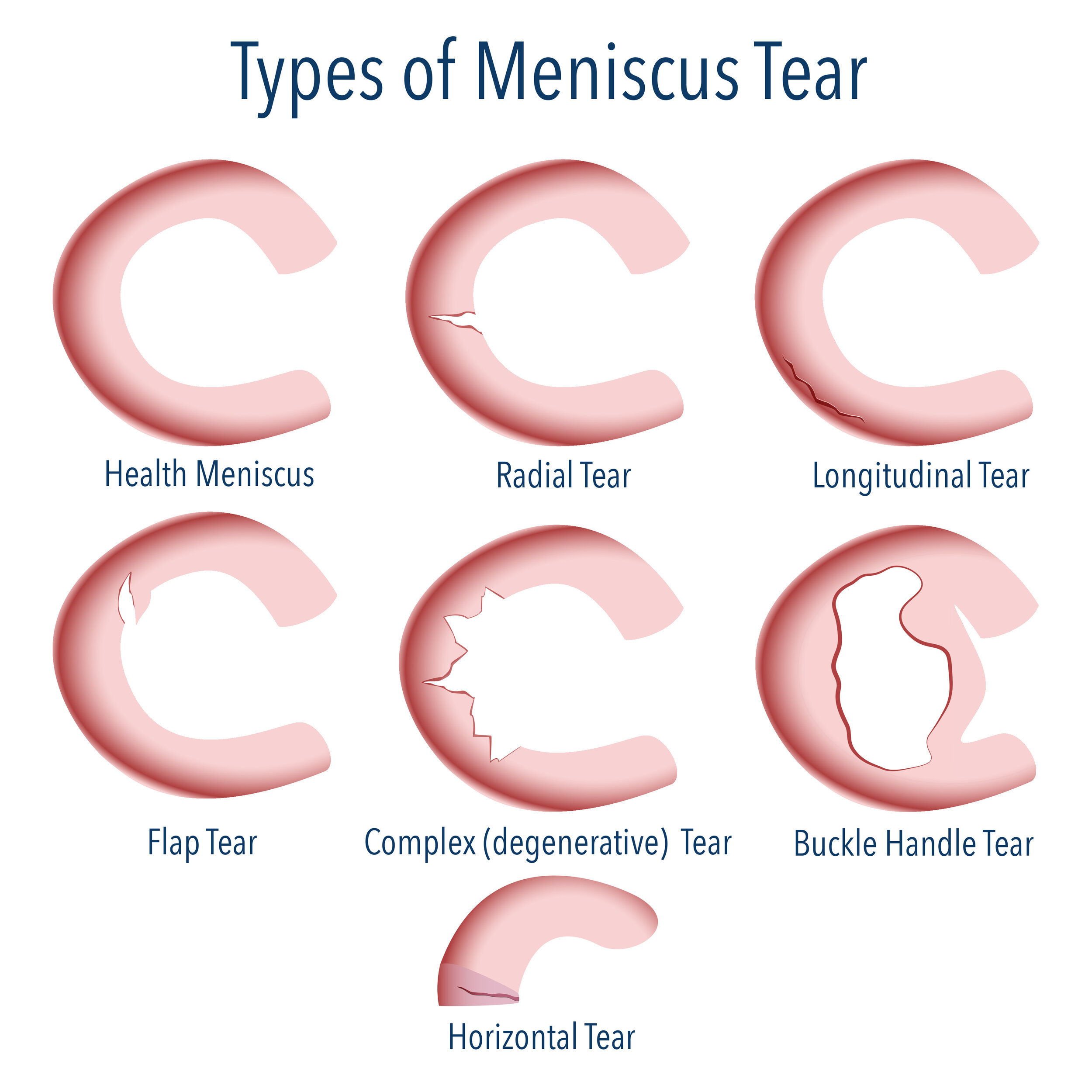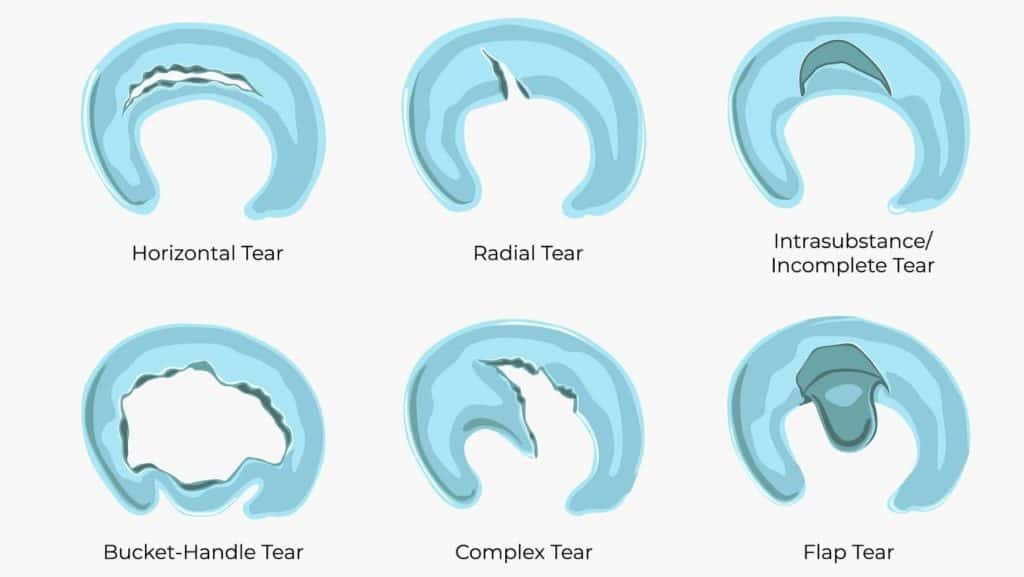Understanding Meniscus Tears

Think of your knee as a high-performance sports car, and the meniscus is like the shock absorbers. It’s a C-shaped piece of cartilage that acts as a cushion between your thighbone (femur) and shinbone (tibia). It helps distribute weight evenly, provides stability, and allows smooth movement. But just like any high-performance part, the meniscus can get damaged, leading to a tear.
Types of Meniscus Tears
Meniscus tears can happen in different ways, creating various types of tears. The most common types are:
- Horizontal Tear: Imagine a crack running across the meniscus, like a line on a piece of paper. This type is usually caused by repetitive stress, like running or jumping.
- Vertical Tear: Picture a tear running up and down the meniscus, like a cut in a piece of cloth. This is often caused by a sudden twisting or bending force.
- Bucket-Handle Tear: This type is like a flap of cartilage that gets torn off, resembling a bucket handle. It’s usually caused by a forceful impact or twisting motion.
Causes of Meniscus Tears
Meniscus tears can happen to anyone, but they’re more common in athletes and people who participate in activities that put stress on their knees. Some of the most common causes include:
- Sports Injuries: Activities like basketball, football, skiing, and tennis can put a lot of stress on your knees, increasing the risk of a meniscus tear. Imagine a basketball player landing awkwardly after a jump, or a skier hitting a bump on the slope.
- Degenerative Changes: As we age, our cartilage can wear down, making it more susceptible to tears. Think of it like a worn-out tire, more likely to get a puncture.
- Direct Injury: A direct impact to the knee, like a car accident or a fall, can also cause a meniscus tear.
Treatment Options

So, you’ve got a meniscus tear. It’s like your knee’s got a bad case of the Mondays, and it’s making it hard to move. But don’t worry, there are options to help get your knee back in the game! Doctors will usually recommend a course of treatment based on the severity of the tear and your activity level. Let’s break down the options, like a menu at a fancy knee-joint restaurant.
Non-Surgical Treatment
If your tear isn’t too bad, your doctor might recommend giving it a rest and trying some non-surgical treatments. Think of it as a knee-focused spa day. These treatments can help reduce pain, swelling, and inflammation, and might even help the tear heal on its own.
- RICE: This acronym stands for Rest, Ice, Compression, and Elevation. It’s like the first aid kit for knee injuries. Resting your knee gives it a chance to heal, ice reduces swelling, compression helps keep things stable, and elevation helps drain fluids.
- Physical Therapy: Think of this as a personal trainer for your knee. A physical therapist can help you strengthen your leg muscles, improve your range of motion, and learn how to move safely with a meniscus tear. They’ll also give you exercises to do at home to keep your knee in tip-top shape.
- Medications: Over-the-counter pain relievers like ibuprofen or acetaminophen can help with pain and inflammation. Your doctor might also prescribe stronger pain meds or anti-inflammatory medications if needed.
Surgical Treatment
Sometimes, a meniscus tear is too severe for non-surgical treatments, and surgery is the best option. The most common type of surgery is called arthroscopy. It’s like a mini-vacation for your knee, with a super-tiny camera and tools going in to fix things up.
- Arthroscopy: This procedure is done using a tiny camera and surgical tools inserted through small incisions. It allows the surgeon to see the inside of the knee and repair or remove the torn meniscus. Think of it as a high-tech knee repair shop, but without the greasy mechanics.
Comparing Treatment Options
So, which treatment is right for you? It depends on your specific situation, but here’s a quick rundown of the pros and cons:
| Treatment Option | Advantages | Disadvantages |
|---|---|---|
| Non-Surgical Treatment | Less invasive, quicker recovery time, no surgery risks | May not be effective for all tears, may not fully heal the tear |
| Surgical Treatment | Can repair or remove the torn meniscus, can provide long-term relief | More invasive, longer recovery time, potential complications |
A meniscus tear is a common knee injury, often occurring during sports or other activities involving twisting or pivoting motions. This tear can affect the cartilage that cushions the knee joint, leading to pain, swelling, and difficulty moving the knee.
A torn meniscus, which can occur due to a sudden impact or repetitive stress , can result in varying degrees of pain and instability, requiring treatment options ranging from physical therapy to surgery.
A meniscus tear is a common knee injury that can occur from sudden twisting or impact. This injury can be incredibly painful and debilitating, often requiring surgery or physical therapy. A torn meniscus is a specific type of meniscus tear that involves a complete or partial tear in the cartilage.
Depending on the severity and location of the tear, treatment options may vary from conservative measures like rest and physical therapy to more invasive surgical procedures. Regardless of the approach, understanding the nuances of a meniscus tear is crucial for effective treatment and recovery.
